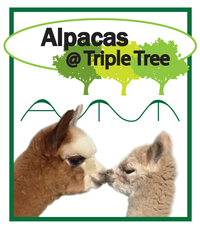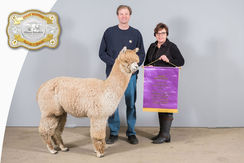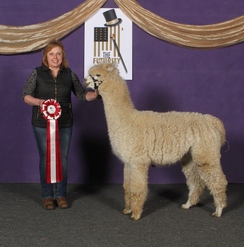About Alpaca Fiber
Alpaca fibre is one of the most incredible natural fibres known – it is soft, durable and great to wear. Perhaps the most remarkable aspect of alpaca is the fact that it is still not a familiar choice for the majority of consumers.
While alpaca fleece can be softer than cashmere, stronger than wool and very beautiful, not all alpaca fibre is premium. Generally, only very fine, prime grade fleeces that average fewer than 22 microns with less than 5% of the fibres larger than 30 microns are suitable for wearing against the skin.
The highest-end alpaca items are hand-knit or woven by skilled artisans in 100% alpaca yarns. Other garments are blended with other natural fibres and synthetics for durability and affordability. From very fine examples of hand-knit sweaters to casual, blended tunics made for weekends; you won’t find any fibre more suited for all levels of fashion than alpaca.
However, lesser quality fleeces are very useful and still superior to other fibres in many ways. Coarser fibre from skirting remains soft and can be used in high-end carpeting, outerwear, upholstery, rugs and many other products. Lower grades are often used as batting to increase warmth, such as inside duvets and even as insulation in the walls of structures.
The complete picture of how alpaca is used can only be clear when you take into account the whole spectrum of grades. All alpaca fibre may not be the finest, but all fibre from alpacas can be used – therefore, alpaca fibre is extremely practical because none goes to waste.

Women sort alpaca fibre in Peru. This valuable skill is passed from generation to generation.
In fact, almost half of the alpaca that is sold in International markets is between 29 and 31 microns, the coarser end of the spectrum.
From a marketing viewpoint, it is important to brand the finest fibre as a luxury material used in haute couture and high fashion to separate it from the second and third grades. Fashion designers with end goals of next-to-skin, refined garments avidly seek the finer fleece.
The topic of alpaca fibre is tactile, complex and multi-layered. Even those who have been in the business for years admit there is a learning curve. However, that’s what makes it so interesting – the variety of goods that can be made from alpaca fibre is nearly limitless.
There are two types of alpacas: Huacayas, which are more numerous worldwide, and Suris, which make up around 10% of the population – both varieties are sought after for their remarkable fibre. Huacayas have crimped fibre that stands perpendicular to their skin so they look fluffy, like a teddy bear. Suris have long bundles of locks that hang straight down from their skin, and they usually have a part along their back. Under the microscope, Suri fibre has a slightly lower scale relief than Huacaya, which gives it a silkier feeling.

The reason for alpaca fibre’s legendary softness is evident under the microscope.
The myriad benefits of alpaca fibre:
- Exceptionally soft due to low scale relief (Suri scale relief is even lower than Huacaya). This gives alpaca its famous silky, soft feeling, or “hand.”
- Very fine diameter (well-bred animals now commonly reach the 13 micron mark).
- Fine grades have low prickle factor, which equates to comfortable wear and smooth, next-to-skin applications.
- Water repellency allows alpaca outerwear to remain comfortable even when damp – it absorbs up to 20% of its weight in water with no negative sensation for the wearer.
- Moisture wicking. For accessories like luxury socks, alpaca moves the wearer’s perspiration away from the skin, resulting in long, comfortable wear.
- Non-irritating and hypoallergenic. Many people who cannot wear wool next-to-skin find fine alpaca very comfortable. Lanolin in sheep’s wool often triggers allergic reactions in wearers, leading to discomfort. Alpaca has virtually no lanolin, and thus, feels better for more people.
- Thermic. The warmest garments available to luxury consumers today are made from alpaca. If you live in a bitterly cold climate, nothing keeps you warmer. Besides being warm in winter, alpaca is cool in summer – particularly blends made with alpaca.
- Lightweight. The tremendously light and airy feeling of alpaca makes its incredible thermic qualities unbelievable. Designers are free to employ fancy stitches such as cable knit with no fear of heaviness.
- Wide spectrum of beautiful, natural colors. Available in at least 22 natural colors with white dyeable to any color. This makes natural alpaca a perfect ready-made candidate for eco-lines of yarn, textiles and garments.

Alpacas come in a rainbow of at least 22 natural colors.
- Little static. This allows manufacturing to go smoother and clothes to drape with less cling.
- Flame-resistant. Alpaca can be used in such garments as infant pajamas, which benefit from flame retardant qualities. When tested with an open flame, alpaca will not burn.
- Less lanolin. Less lanolin means shorter scouring cycles with the opportunity to use eco-friendly soaps in manufacturing.
- Shine. The shiny quality of Huacaya fibre is referred to as brightness while the shiny quality of Suri fibre is called luster. In both types, this very beautiful side effect is the result of low scale relief.
- Feltable. Alpaca felt is readily and can be used for both practical projects like airplane panel sound-deadeners and for artistic pursuits. Many contemporary artists use alpaca fibre in textile art.
- Durable. Alpaca has one of the highest resistance factors of all natural fibres, which is ideal for practical items that must endure hard use. Super baby alpaca is just as soft as cashmere but has much more tensile strength. A human hair’s resilience is rated at 100, wool is 122.8 and mohair is 136. Alpaca, however, is rated at 358.5.
- Wrinkle resistant. Allows garments to drape beautifully and wear neatly all day.
- Blendable. Alpaca pairs wonderfully with both natural and synthetic fibres, thus multiplying its usefulness in the textile world almost infinitely. A distinct benefit alpaca brings to other fibres is its added softness.
Really, a fundamental understanding of alpaca fibre can be achieved in seconds – just one touch of a high-end alpaca garment makes its appeal immediately clear. Used in a dizzying array of products, alpaca fibre is gaining ground with every passing year and taking its place on the world stage of natural luxury fibres.
Meyla Bianco Johnston | 25 July 2016
Thursday, July 20, 2017



